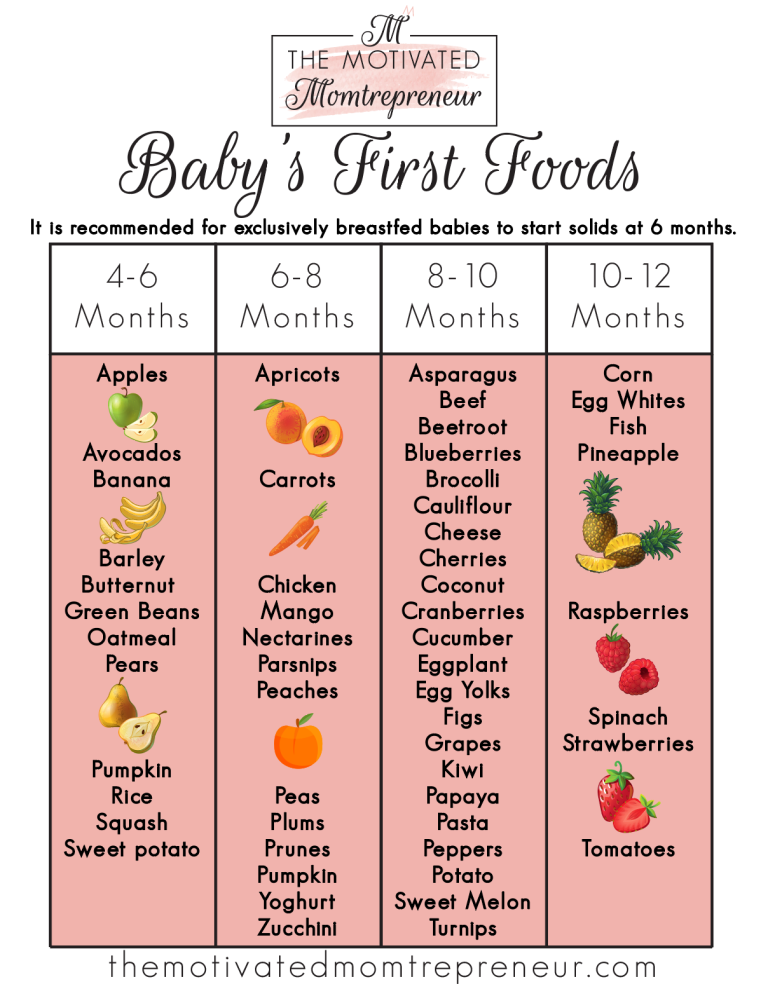Sharing is caring!

I do have affiliate links throughout this blog. The links provide me with a small commission at no extra cost to you!
The American Academy of Pediatrics recommends introducing food as a complement to breastmilk or formula to babies after 6 months of exclusive breastfeeding or formula feeding. It is not recommended to start with solids before 4 months of age. Every baby is different and will show signs of readiness at different times.
Signs Your Baby Is Ready For Solids
- Able to sit with or without support
- Can hold their head steady and control head and neck
- Shows interest when you are eating and opens mouth when food is offered
- Has lost tongue thrust reflux and doesn’t spit food out
- Developing a “pincer” grasp – where baby can pick up objects between thumb and forefinger
How To Introduce My Child To Solids
Solids should be had as a complement to breast milk or formula. First feed your baby their milk, then food. Start with one individual food item at a time, and after a few days at a time, introduce something new. Doing this will make it easier to eliminate foods that your child seems to have a problem with – like food they have an allergic reaction to.
Do watch your baby for signs of hunger before feeding and cues of being full to know when to stop. This is responsive feeding and will help your child develop healthy eating habits. Never force a child to eat when they are full. Get baby used to eating at scheduled times to get into a routine – if they aren’t hungry at those times, don’t force it just go with the flow.
What To Start With First
Soft pureed foods are important to give a baby at first till they start learning how to chew and can handle soft finger foods and gradually ease into eating more. It is recommended to offer rice cereal, iron-fortified cereals, pureed poultry or meat, beans, and pureed vegetables, as they are very nutritious. You can also add breastmilk to your baby’s cereals.


At first, feed your baby milk as breast milk or formula should be their main source of nutrition, thereafter offer 1-2 teaspoons a day to your baby. As baby grows you can adjust to meet their hunger cues. By a year, your baby should be eating 3 meals a day as well as breastmilk or formula. They should also be eating everything at this age, just cut into smaller pieces for them.
It is recommended to introduce allergenic foods early and regularly to reduce the risk of being allergic to them – please check with your pediatrician first and do not take medical advice from this blog post. Honey should not be given to babies under 1 year old – it may carry clostridium botulinum, the bacteria that causes botulism. Their digestive systems are underdeveloped and cannot fight off botulism which is a serious illness that can cause long-term side effects or death.
Allergenic Foods:
- Peanuts and tree nuts
- Egg
- Cow milk
- Wheat
- Fish
- Soy
How To Prepare Baby Food
- Don’t offer food that needs to be chewed on
- Be aware of choking hazards, such as small, hard foods like nuts, whole grapes, or popcorn. Always supervise your baby while they eat.
- Offer food in a way that’s easy to eat – such as pureed, or mashed up, it should be very smooth
- After preparing meals such as oats, or barley, grind it to make it easier to swallow
- Cut grapes, cherries, etc. into small pieces
- Make sure to remove seeds before serving
- Cook hard fruits and vegetables until they are soft
- Mix foods with breast milk, formula, or water to make it easier to swallow
- Monitor your baby when they are eating and offer small portions at a time.
- Don’t add sugar, salt, or spices to your baby’s food. Babies have sensitive palates, and it’s always great to let them experience natural flavours.
- If you’re introducing allergenic foods like eggs, peanuts, or seafood, consult with your pediatrician and introduce them one at a time in small amounts, watching for any adverse reactions.
Encourage your baby to explore and feed themselves. It may be messy, but it’s part of the learning process. Offer one food at a time and let your baby pick up and explore different flavours and textures. Meals should be a positive experience. Try to have meals together with baby and offer them the same food as you. Your baby may not want to eat too much initially, and that’s fine. Don’t force-feed them if they’re uninterested. Make sure your baby is sitting up safely in a feeding chair.
Keep in mind that every baby is different, and the pace at which they take to baby-led weaning can differ. Be patient, and enjoy the process. If you have any concerns about your baby’s development or feeding, consult with your pediatrician.
Baby Led Weaning Recipes
- Sweet Potato Fries:
- Slice sweet potatoes into finger-sized strips.
- Toss with a little olive oil and bake until soft and slightly crispy.
- Serve with a yogurt-based dipping sauce.
- Mini Veggie Omelette:
- Whisk eggs and pour into mini muffin cups.
- Add finely chopped vegetables like spinach, bell peppers, and tomatoes.
- Bake until set and serve as mini omelette bites.
- Quinoa and Avocado Mash:
- Cook quinoa until soft and cool it down.
- Mash ripe avocado and mix it with quinoa for a nutritious mash.
- Mini Chicken and Veggie Balls:
- Combine ground chicken, grated zucchini, and finely chopped carrots.
- Roll into mini meatballs and bake until cooked through.
- Banana and Blueberry Pancakes:
- Mash ripe bananas and mix with blueberries.
- Add a beaten egg and a bit of oat flour (or oats finely ground in a blender).
- Cook mini pancakes on a griddle.
- Baby’s First Smoothie:
- Blend together ripe bananas, yogurt, and a small amount of baby-friendly fruits like mango or pear.
- Serve in a sippy cup.
- Mini Cheese and Spinach Quesadillas:
- Place a small amount of cooked spinach and grated cheese between two small tortillas.
- Cook until the cheese is melted and the tortillas are slightly crispy.
- Cut into baby-sized wedges.
- Cauliflower and Broccoli Nuggets:
- Steam cauliflower and broccoli until soft.
- Mash and mix with breadcrumbs and a little cheese.
- Form into small nuggets and bake.
- Mashed Peas and Carrots:
- Steam peas and carrots until very soft.
- Mash together or blend for a smooth texture.
- Mini PB&J Sandwiches:
- Spread a thin layer of peanut butter (if not allergic) and fruit puree (like strawberry) between two small pieces of bread.
- Cut into baby-friendly shapes.
- Apple and Cinnamon Oat Bites:
- Mix rolled oats, grated apple, and a pinch of cinnamon.
- Form into small balls and bake until slightly crispy.
- Pumpkin and Banana Muffins:
- Combine mashed banana and pumpkin puree with a little flour and baking powder.
- Bake as mini muffins.
Sharing is caring!

One Response
May I simply say what a comfort to discover someone that really knows what they are talking about on the internet. You actually realize how to bring an issue to light and make it important. More people must look at this and understand this side of the story. I cant believe you are not more popular since you surely have the gift.